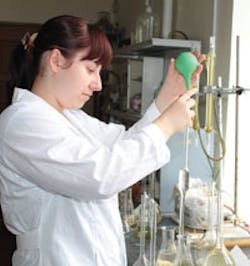New Sewage, New Treatment
The composition of sewage is constantly changing. More hazardous and toxic pollutants are becoming a challenge, requiring a combination of old and new methods of wastewater treatment.
With funding from the Alcoa Foundation Advancing Sustainability Research: Innovative Partnerships for Actionable Solutions initiative, the Fund for Sustainable Development, Institute of Water Problems, Educational Center for Ecology and Safety, and Samara Technical University are collaborating to establish recommendations for bettering responsible water management for sustainable development at federal, regional and municipal levels in Russia. The partner organizations are conducting research that reviews advanced wastewater treatment methods. One specific project is research on oily industrial wastewater treatment using biological elements—known as phyto-technologies.
For several years, the academic departments of chemical technology and industrial ecology at Samara State Technical University have been researching more cost-efficient biological treatment methods, which are carried out with minimum waste production and energy consumption. This research has a broader application to wastewater treatment in Russia and around the world.
Preventing Pollution
Samara is an industrial town and the sixth largest city in Russia, based at the confluence of the Volga and Samara rivers. The Volga is an integral part of the city’s economic development and is facing problems of anthropogenic impact on surface waters, including oily wastewater pollution. Responsible wastewater management generated by these industries is of critical importance to maintain the river’s environmental health and recreational value.
Research was led by students from three universities in the Samara region who studied methods to purify water contaminated by oil products, iron ions, sulfate ions, chromium ions and other industrial pollutants through the use of plants (phyto-treatment).
Typically, biological treatment facilities for wastewater use filtration fields, irrigation and biological ponds. There are three system options:
- 1. Stabilization pond system: These open ponds, where algae is grown photosynthetically, generate oxygen used by bacteria to break down organic compounds in water. The process generates carbon dioxide, which is caught and fixed during photosynthesis of algae.
- 2. Ponds: These systems mix both indoor and outdoor pools. Characterized by a high rate of algal treatment, there has been rapid growth in pond technology and increasing comparison with conventional stabilization systems.
- 3. Photobioreactors: These are closed systems. They have the highest financial costs and operating costs, but generate more algae biomass per liter.
Stabilization systems usually are the most inexpensive; however, pond systems are more efficient due to the assimilation of nutrients in wastewater. Photobioreactors are considered the most costly and are not widely distributed.
Research & Results
Plants accustomed to the Russian climate were used in the university research. Each plant species used in the research was grown in algae farms and ponds, and was distinguished by efficiency, viability, stages of development, fertility and purification performance. The most common biological treatment for different wastewater flows uses unicellular alga Chlorella (Chlorella vulgaris). This species handles more toxic pollution, such as petroleum products.
More recently, green filamentous algae have been utilized for their large absorption capacity. In the presence of only 1 gram of biomass per liter of polluted water, in less than two days these algae can treat 14 mg of ammonium nitrogen, almost 7 mg of nitrate, and 1.5 mg phosphorus. They also can actively consume magnesium, potassium, sulfur, cobalt, zinc, cadmium, lead and other heavy metals.
Other plant options are more favorable to other climates. For example, water hyacinth, which hails from tropical Venezuela, multiplies very quickly under favorable conditions. In addition, narrow-leaved cattail, broad-leaved pondweed, yellow iris, arrowhead and buckwheat are also often considered for biological water treatment. Other countries often use microalgae for these systems, as they easily adapt to the environment.
In one experiment, researchers from Samara State Technical University treated wastewater utilizing Urrutia whorled, a common higher aquatic plant with a submerged root system, which is hardy, easily propagated and grows all over the globe. Polluted water was poured into a tank to measure the concentration of pollution, and then the water entered an inlet chamber, where Urrutia was located in a special metal conduit (made of stainless steel alloy to reduce the possibility of corrosion). The polluted water stayed in the chamber with the Urrutia for two hours. After the water was purified, it was moved into a chamber, where the pollution concentration of the water was measured again. The purified water in this third chamber was lacking hexavalent chromium, an industrial pollutant from ore processing, indicating that Urrutia purified the water. This experiment format also can be used for research of other aquatic plants with similar ecosystems.
Biological Balance
Russian companies have developed and patented a number of unique technologies to create artificial systems that support the biological balance in water reservoirs. These systems include:
- • Atoll: A floating structure several meters in diameter;
- • Floating bed: A floating flower bed with a variety of plants; and
- • Warm polynya: A device designed for the formation of an ice-free zone in the reservoir, which facilitates a constant exchange of gases with the atmosphere during freezing temperatures.
The research has found the use of plants to treat oily wastewater successful, helping researchers understand a method of cleaning that is efficient, profitable and promising for wastewater treatment in all developed countries of the globe. To disseminate the results of their research more broadly, the partner organizations are working together to redesign the water management curriculum at several universities and hold training sessions to educate business leaders on best practices for oily wastewater treatment.
Download: Here
